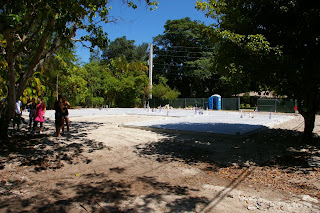Had a site visit today with some of our students from FIU. That's them in the shade, under the avocado tree in the rear yard. The big development at the site is that the contractor graded the lot by spreading out the piles of excavated soil (you might remember the large piles left around the perimeter of the site when they excavated the foundation). The soil is now at the approximate level it will be when the house is complete, which gives us a slightly better sense of how the house will sit on the site when it is complete. For example, we can see the scale and proportions of the courtyard and the patio a little better now (the patio is to the right in this image, under the sapote tree and facing the park across the street.
The porch is also a little easier to picture now that it has been graded. It is the space at left, between the red flag and the concrete slab. This photo is taken from a similar angle to the perspective elsewhere on this blog.
The contractor also left us with separate piles of large pieces of coral, which we're hoping to use in the landscape, probably to help define the raised planting beds. It is a beautiful material, and it's almost all reclaimed from the site.
Our students, by the way, are brilliant, and their feedback on the project is very helpful. One takeaway from today's visit: the need for security. Two of my students have had air conditioning units stolen (one from a house, the other from a church), which suggests that we better find a way to make sure anything outdoors (a/c, solar hot water heater, photovoltaics, lightning rods) is pretty secure. At least our photovoltaic panels are stuck down with a strong adhesive. Yikes.
I also learned that we've got to take pest control seriously if we expect to harvest any fruits or vegetables. There has to be a way to share habitat without sharing food. It would be a cruel irony to have to kill a lot of animals in order to enjoy a vegan diet.



Actually Professor, I thought of something that could help with the pest problem. Here is an example: When it comes to butterfly gardens, some plants are meant for their aesthetic value while others are planted as food source and a place for the butterflies to lay their eggs. The goal of this is to attract the butterflies with food but still maintain the beauty of the garden with more beautiful, and consequently less appetizing, plants. I'm sure some "pests" in your locale will prefer some vegetables or plants over others. From there, you can continue to use this "distractor" plant and hopefully the rest of your harvest will make it to your plate scot-free!
ReplyDeleteJeanne
Like I said, our students are brilliant.
ReplyDeleteThat's a great idea, Jeanne. Thank you!